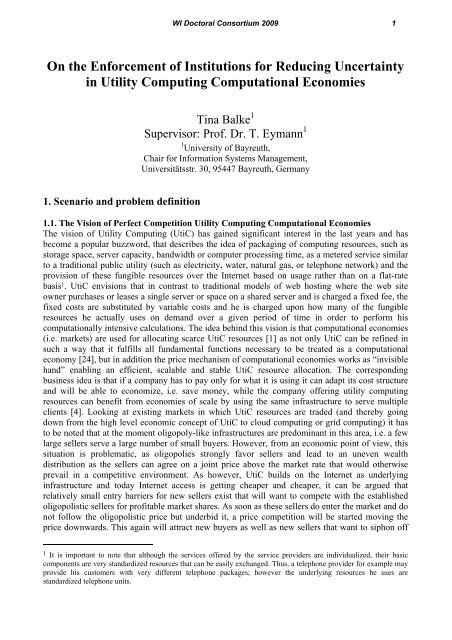Tagungsband zum Doctoral Consortium der WI 2009
Tagungsband zum Doctoral Consortium der WI 2009
Tagungsband zum Doctoral Consortium der WI 2009
Sie wollen auch ein ePaper? Erhöhen Sie die Reichweite Ihrer Titel.
YUMPU macht aus Druck-PDFs automatisch weboptimierte ePaper, die Google liebt.
On the Enforcement of Institutions for Reducing Uncertainty<br />
in Utility Computing Computational Economies<br />
1. Scenario and problem definition<br />
<strong>WI</strong> <strong>Doctoral</strong> <strong>Consortium</strong> <strong>2009</strong> 1<br />
Tina Balke 1<br />
Supervisor: Prof. Dr. T. Eymann 1<br />
1 University of Bayreuth,<br />
Chair for Information Systems Management,<br />
Universitätsstr. 30, 95447 Bayreuth, Germany<br />
1.1. The Vision of Perfect Competition Utility Computing Computational Economies<br />
The vision of Utility Computing (UtiC) has gained significant interest in the last years and has<br />
become a popular buzzword, that describes the idea of packaging of computing resources, such as<br />
storage space, server capacity, bandwidth or computer processing time, as a metered service similar<br />
to a traditional public utility (such as electricity, water, natural gas, or telephone network) and the<br />
provision of these fungible resources over the Internet based on usage rather than on a flat-rate<br />
basis 1 . UtiC envisions that in contrast to traditional models of web hosting where the web site<br />
owner purchases or leases a single server or space on a shared server and is charged a fixed fee, the<br />
fixed costs are substituted by variable costs and he is charged upon how many of the fungible<br />
resources he actually uses on demand over a given period of time in or<strong>der</strong> to perform his<br />
computationally intensive calculations. The idea behind this vision is that computational economies<br />
(i.e. markets) are used for allocating scarce UtiC resources [1] as not only UtiC can be refined in<br />
such a way that it fulfills all fundamental functions necessary to be treated as a computational<br />
economy [24], but in addition the price mechanism of computational economies works as “invisible<br />
hand” enabling an efficient, scalable and stable UtiC resource allocation. The corresponding<br />
business idea is that if a company has to pay only for what it is using it can adapt its cost structure<br />
and will be able to economize, i.e. save money, while the company offering utility computing<br />
resources can benefit from economies of scale by using the same infrastructure to serve multiple<br />
clients [4]. Looking at existing markets in which UtiC resources are traded (and thereby going<br />
down from the high level economic concept of UtiC to cloud computing or grid computing) it has<br />
to be noted that at the moment oligopoly-like infrastructures are predominant in this area, i.e. a few<br />
large sellers serve a large number of small buyers. However, from an economic point of view, this<br />
situation is problematic, as oligopolies strongly favor sellers and lead to an uneven wealth<br />
distribution as the sellers can agree on a joint price above the market rate that would otherwise<br />
prevail in a competitive environment. As however, UtiC builds on the Internet as un<strong>der</strong>lying<br />
infrastructure and today Internet access is getting cheaper and cheaper, it can be argued that<br />
relatively small entry barriers for new sellers exist that will want to compete with the established<br />
oligopolistic sellers for profitable market shares. As soon as these sellers do enter the market and do<br />
not follow the oligopolistic price but un<strong>der</strong>bid it, a price competition will be started moving the<br />
price downwards. This again will attract new buyers as well as new sellers that want to siphon off<br />
1 It is important to note that although the services offered by the service provi<strong>der</strong>s are individualized, their basic<br />
components are very standardized resources that can be easily exchanged. Thus, a telephone provi<strong>der</strong> for example may<br />
provide his customers with very different telephone packages; however the un<strong>der</strong>lying resources he uses are<br />
standardized telephone units.

















